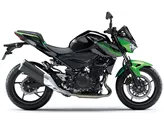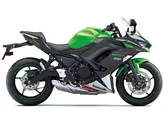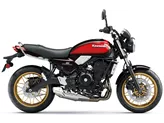Kawasaki Z650 RS 2022 vs. Kawasaki Ninja 400 2023

Kawasaki Z650 RS 2022

Kawasaki Ninja 400 2023
Overview - Kawasaki Z650 RS 2022 vs Kawasaki Ninja 400 2023
The Kawasaki Z650 RS 2022 and the Kawasaki Ninja 400 2023 are both impressive motorcycles with their own unique features and strengths.
Starting with the Kawasaki Z650 RS 2022, this naked bike stands out with its perfectly realized retro design, making it a real eye-catcher on the road. It features analogue displays, which add to its classic appeal. The Z650 RS is equipped with a lively engine that delivers 68.2 HP of power and 65.7 Nm of torque. With a displacement of 649 ccm and a compression ratio of 10.8, this bike offers excellent performance. The fuel system is injection-based, and the throttle bore measures 36 mm. The Z650 RS has a 2-cylinder engine with 4 valves per cylinder, providing a smooth and powerful ride.
In terms of suspension, the Z650 RS features a telescopic fork front suspension with a diameter of 41 mm, ensuring a comfortable and controlled ride. The rear suspension consists of a swing arm with a monoshock absorber and preload adjustment. The frame of the Z650 RS is made of steel and has a tubular design, providing stability and durability. The rake is set at 65.5 degrees, and the trail measures 100 mm.

Kawasaki Z650 RS 2022
When it comes to braking, the Z650 RS is equipped with double disk brakes on the front, with a diameter of 300 mm and double piston technology. This ensures powerful and reliable braking performance. The bike also features ABS as part of its advanced rider assistance systems.
In terms of dimensions and weights, the Z650 RS has a front tire width of 120 mm and a diameter of 17 inches. The rear tire width measures 160 mm, also with a diameter of 17 inches. The wheelbase is set at 1410 mm, providing stability and maneuverability. The seat height is 820 mm, offering a comfortable riding position for most riders. The kerb weight of the Z650 RS, including ABS, is 187.1 kg. The fuel tank capacity is 15 liters, allowing for longer rides without frequent refueling.
Moving on to the Kawasaki Ninja 400 2023, this supersport motorcycle offers a good combination of stability and playful handling. It has a robust and reliable appearance, instilling confidence in the rider. The Ninja 400 is powered by a 2-cylinder engine with a displacement of 399 ccm. It delivers 45 HP of power and 37 Nm of torque, providing a wide usable rev range. The engine features a compression ratio of 11.5 and a fuel system based on injection. The throttle bore measures 32 mm.
The suspension of the Ninja 400 consists of a telescopic fork front suspension with a diameter of 41 mm, ensuring a smooth and controlled ride. The rear suspension features a swing arm with a monoshock absorber and preload adjustment. The frame is made of steel and has a tubular design, offering stability and durability. The rake is set at 63 degrees, and the trail measures 92 mm.

Kawasaki Ninja 400 2023
Braking on the Ninja 400 is handled by a single disk brake on the front, with a diameter of 310 mm and double piston technology. This provides reliable and responsive braking performance. Like the Z650 RS, the Ninja 400 also features ABS as part of its advanced rider assistance systems.
In terms of dimensions and weights, the Ninja 400 has a front tire width of 110 mm and a diameter of 17 inches. The rear tire width measures 150 mm, also with a diameter of 17 inches. The wheelbase is set at 1370 mm, offering stability and maneuverability. The seat height is 785 mm, which may be a limitation for taller riders. The kerb weight of the Ninja 400, including ABS, is 168 kg. The fuel tank capacity is 14 liters, providing a decent range for longer rides.
In summary, the Kawasaki Z650 RS 2022 and the Kawasaki Ninja 400 2023 are both impressive motorcycles with their own unique features and strengths. The Z650 RS stands out with its retro design, analogue displays, and powerful engine, while the Ninja 400 offers a combination of stability and playful handling, along with a reliable appearance. Both bikes feature advanced rider assistance systems such as ABS, ensuring safety on the road. However, the Z650 RS has a slightly softer sound, while the Ninja 400 may have limited space for larger riders. Overall, both motorcycles offer a thrilling riding experience and are worth considering for motorcycle enthusiasts.
Technical Specifications Kawasaki Z650 RS 2022 compared to Kawasaki Ninja 400 2023
Pros and Cons in comparison
Pros and Cons in comparison
Kawasaki Z650 RS 2022

With the RS, Kawasaki proves that it has mastered the art of retro bikes. You immediately forget that underneath the pretty dress is the normal Z650, because thanks to the right details, the retro design has been convincingly implemented. In the saddle, you enjoy the accessibility that you know from the technical sister. A retro bike that both beginners and experienced bikers will really enjoy!
Kawasaki Ninja 400 2023

The Ninja 400 offers a lot of riding fun at a manageable price. It offers playful handling without being nervous. The name "Ninja" is a bit of a mouthful, but the range of use is wider than you might think. It rides sportily, but also offers a good riding position for everyday use and touring.
Price Comparison Avarage Market Price Kawasaki Z650 RS vs Kawasaki Ninja 400
There are a few key differences between a Kawasaki Z650 RS 2022 and a Kawasaki Ninja 400 2023. In terms of price, the actual average price of a Kawasaki Z650 RS 2022 is about 28% higher. Compared to Kawasaki Ninja 400 2023 there are less Kawasaki Z650 RS 2022 bikes available on the 1000PS.de Marketplace, specifically 34 compared to 73. It takes less time to sell a Kawasaki Z650 RS with 146 days compared to 165 days for a Kawasaki Ninja 400. Since model year 2022 1000PS.de editors have written 12 reviews for the Kawasaki Z650 RS and 9 reviews for the Kawasaki Ninja 400 since model year 2018. The first review for the Kawasaki Z650 RS was published on 9/27/2021 and now has more than 39,300 views. This compares to more than 44,300 views for the first review on Kawasaki Ninja 400 published on 11/22/2017.




























